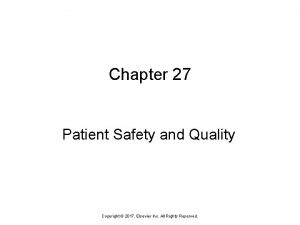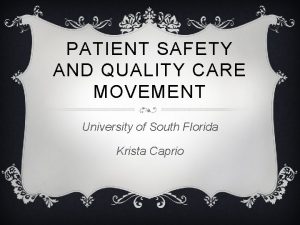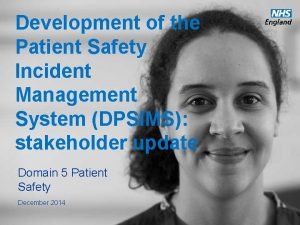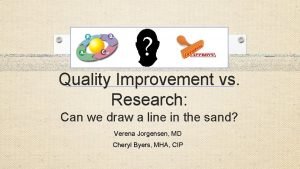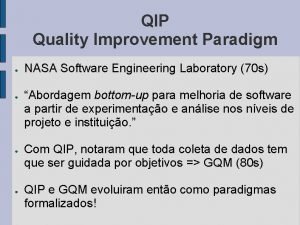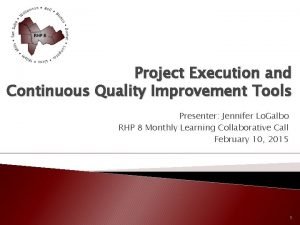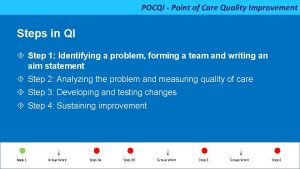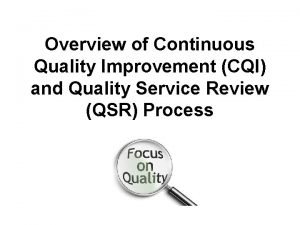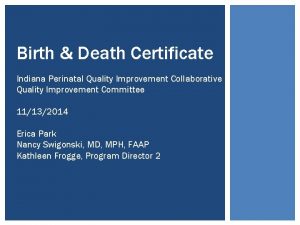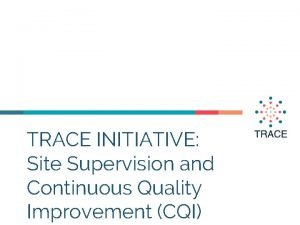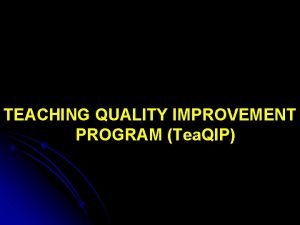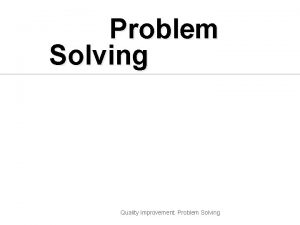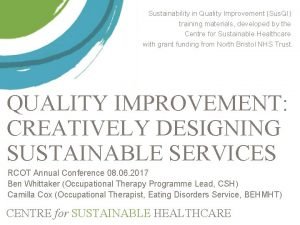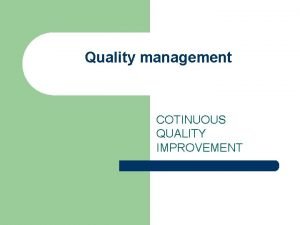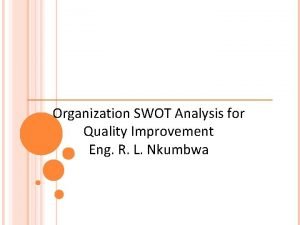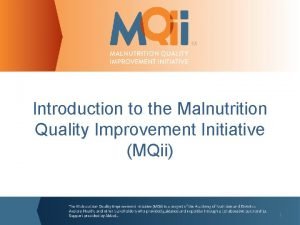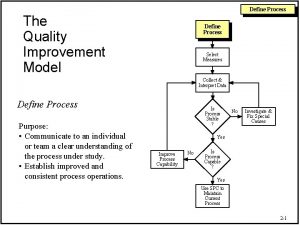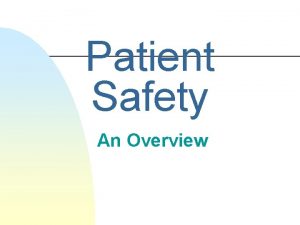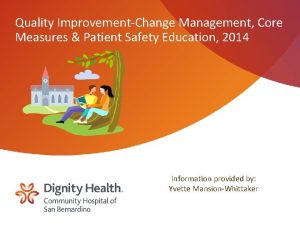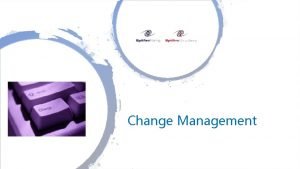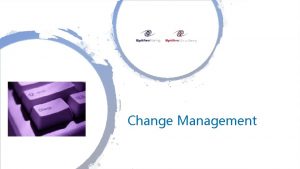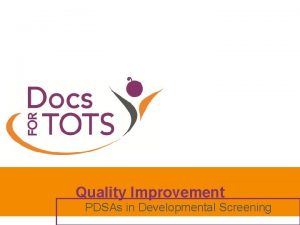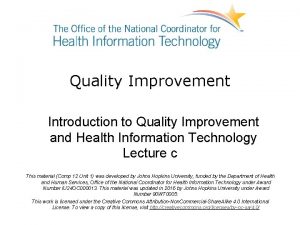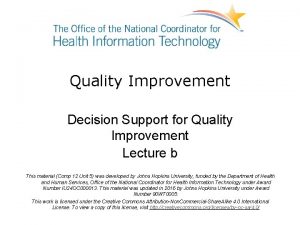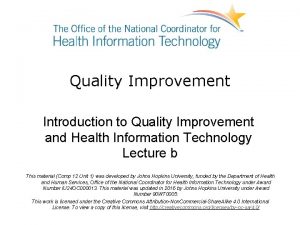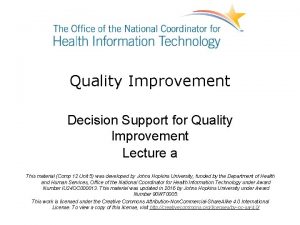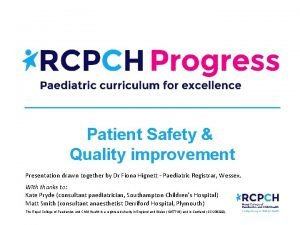Quality Improvement Change Management Core Measures Patient Safety
























- Slides: 24

Quality Improvement. Change Management, Core Measures & Patient Safety Education, 2014 Information provided by: Yvette Mansion-Whittaker

Quality Improvement – Education, 2014. Objectives- The participant will be able to: • Define Quality • Name 2 quality approaches • Name 2 quality tools used at CHSB • Define Value Based Purchasing • Recognize at least 2 Core Measures • Identify 2 of the new core measures 2

What is Quality? MEETING OR EXCEEDING YOUR CUSTOMER EXPECTATIONS. 3

QUALITY APPROACHES • FOCUS-PDCA(Plan, Do, Check, Act). • SIX SIGMA • LEAN SIX SIGMA • TRANFORMATIONAL • TQM (Total Quality Management) 4

CHSB APPROACH TO QUALITY FOCUS PDCA(plan, do, check & act) TRANSFORMATIONAL CARE CORE MEASURES 5

FOCUS PDCA • Based on scientific method known as Shewhart Cycle. • Planned approach to process or problem resolution. • Team focused • Reporting intervals 6

TRANSFORMATIONAL CARE • Change management process • Based on lean principles • Team Focused • Rapid cycle improvement 7

Performance Improvement Monitoring Summary ( PIMS). Currently used to measure compliance with standards or identified opportunities Maintained in Quality Management Department Reported to Quality Council, Medical Executive Committee and Board of Directors

TRANSFORMATIONAL CARE REPORTING TOOLS • Daily Report Huddles • PMT –electronic intranet • Progress monitoring tool • Newsletters 9

Projects can be department specific driven for opportunities or regulatory based. • • • Examples Emergency Dept. Patient Flow Patient Satisfaction Sepsis Timely Discharge Early Recognition of Pediatric Sepsis Readmission Reduction Emergency Collaborative ICU Collaborative

VALUE BASED PURCHASING CORE MEASURES Infection Prevention for Surgical Patients (SCIP) Congestive Heart Failure Acute Myocardial Infarction “Heart Attack” (AMI) Pneumonia 11

VALUE BASED PURCHASING • Core Measures= key measures of care and outcomes for our patients who have had surgery or have been discharged with a diagnosis of: • Infection Prevention for Surgical Patients(SCIP) • Congestive Heart Failure • Acute Myocardial Infarction “ heart attack” (AMI) • Pneumonia 12

NEW CORE MEASURES Tobacco use Substance Abuse Sepsis GI follow up intervals 13

CORE MEASURES FOR CHSB CONT’D. § Children with asthma (CAC) § Blood Clot Prevention (VTE) § Emergency Department ( ED) § Behavioral Health ( HBIPS- or Hospital Based In-Pt Psych. ) § Influenza and Pneumococcal Immunization Program (IMM) § Stroke ( STK) 14

VALUE BASED PURCHASING • Hospital Consumer Assessment of Healthcare Providers & Systems (HCAHPS)= Patient Satisfaction - 8 key categories that measure the patient and family perceptions of care and services • Points are given based on performance at or above the 50 percentile. • Weighted reward -70%- core measures and 30% HCAHPS 15

WHY • PATIENT SAFETY • QUALITY CARE • SAFE WORK ENVIRONMENT • CENTER OF EXCELLENCE 16

CORE MEASURE FOCUS • Timeliness of care § Antibiotics given within 1 hr. § Antibiotics given within six hours of arrival to the hospital. § EKG completed within 15 minutes of arrival to hospital 17

CORE MEASURE FOCUS • Appropriateness of care § Blood cultures are drawn before antibiotics given § Evaluation of the heart for heart failure patients 18

CORE MEASURE FOCUS • Medical practice supported by evidence and research § Cholesterol lowering medication for patients who had a heart attack § Early interventions to prevent blood clot formation such as medication or special stockings §Aspirin use for heart attack §Immunizations for influenza and pneumonia §Continuance of medication (beta blockers) for patients who have surgery 19

CORE MEASURE FOCUS • Preparation of the patient for self care at home Patient education and discharge instructions related to current disease state, activity, diet, symptoms of worsening condition and follow up care • Prevention of Infection Removal of urinary catheters within first two days after surgery Discontinuance of antibiotics within 24 -48 hours of surgery • Outcomes Readmission Rates Mortality or death rates 20

CORE MEASURE FOCUS Hospital Consumer Assessment of Healthcare Providers and Systems (HCAHPS) • 8 key categories that measure the patient and family perceptions of care and services Communication with nurses Communication with doctors Communication about medications Discharge information Pain Management Responsiveness of hospital staff Overall hospital rating 21

WHO DO WE REPORT THEM TO • CMS-Center for Medicare and Medicaid Services (Medi-Cal) Monitoring and payment of services ( Medicare) Medi-Cal is Medicaid in California • TJC- The Joint Commission Private Entity Provides accreditation triennially Provides deemed status on behalf of CMS CDPH- California Department of Public Health State Entity Local Agent for CMS Monitoring and payment of services ( Medi-Cal) 22

WHERE – PUBLIC REPORTING CMS initiated voluntary reporting requirements with a financial incentive in 2003 Hospitalcompare. cms. gov maintains 1 year of performance data (information) for all hospitals and public view. Currently, reporting is required and key measures with substantial performance will be rewarded. 23

WHAT IS OUR RESPONSIBILITY AT CHSB Work as a team to ensure we meet our customers needs Know how our work affects the results both positively and negatively Communicate to our patients and families Achieve our goals Celebrate our successes 24
 Total quality management seminar
Total quality management seminar Compliance vs quality
Compliance vs quality Chapter 27 patient safety and quality
Chapter 27 patient safety and quality Patient safety and quality care movement
Patient safety and quality care movement Safety incident management system
Safety incident management system Repeated measures design
Repeated measures design Patient 2 patient
Patient 2 patient Jhm irb
Jhm irb Patient centered care qsen examples
Patient centered care qsen examples Quality improvement paradigm
Quality improvement paradigm Define continuous quality improvement
Define continuous quality improvement Point of care quality improvement
Point of care quality improvement Define continuous quality improvement
Define continuous quality improvement Efmd quality improvement system
Efmd quality improvement system Indiana perinatal quality improvement collaborative
Indiana perinatal quality improvement collaborative Continuous quality improvement program planning worksheet
Continuous quality improvement program planning worksheet Tea quality improvement
Tea quality improvement Quality improvement
Quality improvement Sustainability in quality improvement
Sustainability in quality improvement Quality improvement nurse
Quality improvement nurse Quality improvement
Quality improvement Juran 10 steps to quality improvement
Juran 10 steps to quality improvement Swot analysis quality improvement
Swot analysis quality improvement Mqii
Mqii Quality improvement
Quality improvement


